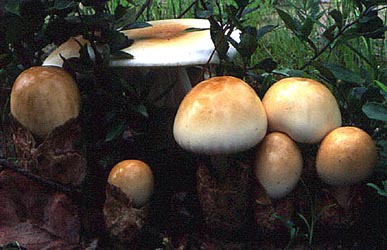|
[ Sectioná Caesareae page. ]
[ Amanita Studies ]
[ Keys & Checklist/Picturebooks ] "Zambian Slender Caesar"
Technical description (t.b.d.) BRIEF DESCRIPTION: The cap of A. zambiana is 100 - 250 (-250) mm, globose to ovoid when young, expanding to applanate with decurved margin, lacking in an umbo, viscid, glabrous, nonappendiculate, with a striate margin. It is olivaceous brown over disk, progressively paler toward margin, and white at the margin. The flesh is white and up to 10 mm thick above the stem. The volva is absent. The gills are free and remote, very crowded, white, ventricose, and up to 15 mm broad. The short gills are truncate to rounded truncate to subattenuate, of three or more lengths, and unevenly distributed. The stem is 100 - 150 x 15 - 20 mm, whitish, stout, cyndrillic, fibrillose, and soon hollow. The sac-like volva is 50 - 90 x 30 - 40 mm, blackish brown on exterior surface which cracks into plaques, red-brown on inner surface in most mature exsiccata; it is pallid at base. The spores measure (9.9-) 10.0 - 13.5 (-21.0) x (7.0-) 7.8 - 10.8 (-12.5) Ám and are broadly ellipsoid to ellipsoid (occasionally subglobose or elongate) and inamyloid. Clamps are common at bases of basidia. The species was originally described from Zambia and is common in season in central Africa. This name may be a synonym of Amanita loosii Beeli (originally described from Congo);
however, the latter is described as being entirely white from the first and developing some discoloring over the
center of the cap. I have examined considerable material of this African species, but have never seen it fresh. Photo: David Arora
[ Sectioná Caesareae page. ]
[ Amanita Studies ]
[ Keys & Checklist/Picturebooks ] Last changed 8 March 2009. |
